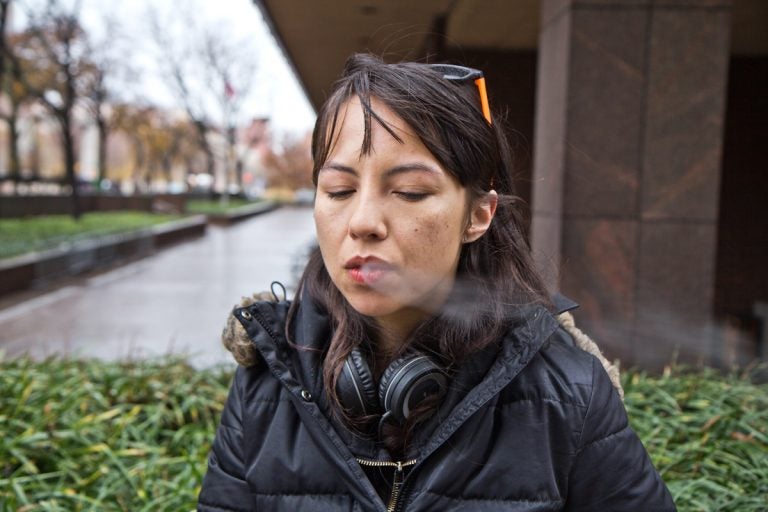How vaping restrictions could send ex-smokers back to cigarettes
New policies meant to curb the youth vaping epidemic could hurt adults who vape to quit
Listen 09:44
Reporter Liz Tung quit smoking with e-cigarettes. (Kim Paynter/WHYY)
I started smoking when I was 15 years old — and from the beginning, I was in love.
I connected to the ritual of it, the romance of it, the brief windows of solitude it offered — huddled on our back porch in the predawn cold, sending clouds of steam and smoke into the sky.
In high school, it helped carry me through the anxiety of Advanced Placement tests and college applications. Later, cigarettes became my way in. From college on through my early 20s, I made some of my first and longest friendships on the fringes of smoking circles.
I knew smoking was bad for me, but I thought of it as a temporary situation. Year after year, I promised myself I’d quit — first, when I turned 20, then 25, then 30. I made half-hearted attempts, using nicotine gum, the patch, a popular cold-turkey method called Alan Carr’s Easy Way to Quit Smoking. None of it worked.
In the meantime, I’d started developing a growing sense of dread. Every time I went out for a cigarette, I could hear a little voice in my head: “You’re killing yourself; you’re killing yourself.”
Finally, last summer, it hit me: I was coming up on 20 years of smoking. That rattled me.
I’d recently had a friend die from cancer. I imagined how it would feel to become that sick and to know it was all my own doing. I imagined leaving my husband alone, the way my friend’s husband was now — spending his evenings at the gym, he said, to avoid going home to an empty house.
Then suddenly, a solution presented itself — vaping. In the span of a single month, half a dozen smokers told me they’d managed to quit smoking using Juul, the e-cigarette that’s gained national notoriety for turning a generation of teens on to vaping.
So I decided to give it a try. Within a week, I’d totally made the transition from smoking to vaping.
People asked me if I felt any difference — in my lungs, my sense of taste or smell, my circulation — and the truth was that I didn’t.
What I did notice was a sense of relief. After years of shadowing me, the specter of fear and dread had disappeared.
The rise of an epidemic
But that feeling didn’t last long. About a month after I quit smoking, reports started to emerge about a mysterious vaping-related illness that was sweeping the country — what the Centers for Disease Control and Prevention would eventually name EVALI, or e-cigarette, or vaping, product use associated lung injury.
I tried to ignore the coverage — until I received a text from my mom with a link to a New York Times article, “Cases of Vaping-Related Lung Illness Surge, Health Officials Say.”
“Don’t know if you’re still vaping,” she wrote, “but these reports are quite alarming.”
And they were. With every week came horrific new stories of injuries that resembled chemical burns, teens receiving lung transplants, and the growing tally of the sick and dead.
In the meantime, the Food and Drug Administration and the CDC had launched investigations into the source of the illness. They still didn’t know the cause, but had found evidence that cartridges containing CBD and THC were implicated.
“I heard on NPR that the injuries were associated with cannabis cartridges,” I texted back.
“Hemp products are implicated in some cases, but not all,” she responded. “They just don’t know yet what’s causing it.”
She was right. In early September, the CDC released a statement emphasizing that its investigation was ongoing, and warning the public against using vaping products of any kind.
The warning heralded a tidal wave of anti-vaping backlash. A flood of media reports echoed concerns about the dangers and potential dangers of e-cigarettes.
Juul became the target of dozens of lawsuits over vaping-related injuries, along with fraudulent advertising practices.
State and city governments started proposing wide-ranging restrictions on vaping, with some banning their sale altogether.
Even my doctor told me I needed to stop vaping, warning that e-cigarettes were just as dangerous as smoking — maybe worse.
Finding the source of EVALI
Despite all the warnings, I wasn’t ready to give up vaping — I knew there was a good chance that without e-cigarettes, I’d go back to my trusty Camels.
So I decided to investigate: Were e-cigarettes truly as dangerous as everyone said?
According to Mike Siegel, a longtime tobacco researcher and professor at the Boston University School of Public Health, the answer is a resounding no.
“There is no evidence whatsoever that e-cigarettes have anything to do with the EVALI outbreak,” he said. “We have to completely separate out the issue of this lung disease outbreak from e-cigarettes. They have nothing to do with each other.”
Instead, Siegel said, the evidence pointed to vitamin E acetate, a thickening agent that’s only used in THC cartridges, not in nicotine liquids.
If that was the case, then how and why had e-cigarettes as a whole continued to be targeted?
Siegel said it all goes back to the CDC.
“From the very beginning, the CDC really ignored very strong evidence that this was related to THC products and not to e-cigarettes,” he said. “As time went on, the CDC finally was forced to admit that in fact this was being caused by THC vaping. The problem, though, is that it took them about two months before they finally admitted that, even though the evidence was pretty clear.”
By that time, the public impression had already been set — which Siegel said may have actually made the EVALI outbreak worse.
“I think that the warning the CDC gave was so vague, basically saying, you know, ‘Just don’t vape, don’t vape anything,’ that nobody really listened to it — certainly youth didn’t get the message that vaping black market THC products was extremely dangerous,” he said. “I think had the CDC been direct with our nation’s youth and just said, ‘Look, guys, you right now should not be vaping THC, period. It’s just too dangerous,’ I think they would have been able to listen to that, and I think that there would have been fewer cases.”
The ‘moral panic’ about vaping
Some experts in the tobacco-control world think that this miscommunication — and the ensuing backlash — was no accident.
“I think undoubtedly that what we’re seeing here is a moral panic,” said David Sweanor, a Canadian tobacco-control expert and law professor at the University of Ottawa. “This is no longer something that’s based on facts, on science, on reason. We have all the hallmarks of the beginning of the war on drugs or the war on alcohol that brought Prohibition.”
In this case, Sweanor said, a different kind of religion is driving the panic.
“We’ve had ideology at places like the CDC being very anti-nicotine or anti any sort of tobacco or vaping product — this taking precedence over the science,” he said.
In an emailed statement, Brian King, the chief science officer for the CDC’s vaping-related outbreak response, refuted Siegel and Sweanor’s charges.
“We followed a methodical and science-based approach to investigating EVALI,” he said. “Specifically, as further data were obtained, recommendations were refined to best protect public health.”
King said the CDC’s EVALI investigation included a broad range of data collection and analyses — including cutting-edge lab techniques — that led it to pinpoint vitamin E acetate as the likely culprit.
“However, evidence is not sufficient to rule out the contribution of other chemicals of concern,” King said, “including chemicals in either THC or non-THC products, in some of the reported EVALI cases.”
Specifically, King said, lung injuries that preceded the current outbreak, along with victims who denied using THC products, justified their concern that EVALI could be linked to e-cigarettes more generally.
While the CDC acknowledged that e-cigarettes could have some benefit as a smoking-cessation aid, it added that there currently isn’t enough evidence to recommend them for that purpose.
“It’s also essential that we look at the net impact of these products on public health,” King said. “Any potential benefit of e-cigarettes among adult smokers cannot come at the expense of escalating rates of use of these products among youth. We currently have an epidemic of youth e-cigarette use in the United States, a population for which there [are] no redeeming aspects for these products.”
The CDC isn’t alone in its concerns about e-cigarettes. In recent months, several studies have been published showing that vaping may pose a serious threat to the lungs and heart. But Mike Siegel, the Boston University researcher, is skeptical of those claims.
“The research that is being cited in support of this connection is really not … valid, in my opinion, because it didn’t control for the person’s history of smoking,” he said.
In other words, the studies didn’t account for the possibility that the lung and heart disease could be the result of years of smoking.
“We know that people who smoke, it takes them two or three decades at least before they develop lung disease,” Siegel said. “So how are you going to get chronic lung disease from vaping for three years? It’s really an absurd and biologically implausible hypothesis to begin with.”
Again, Sweanor said, research like this is the result of an anti-nicotine ideology.
“We have researchers who cross the line from being researchers to being propagandists,” he said.
“They have an agenda. They’re looking for a way to promote their view. And science seems to be used as simply a mask for showing the view of the world they want to show, rather than trying to find out where are the facts in this.”
The result has been a split in the fields of public health and tobacco research, with some experts hailing e-cigarettes as a valuable tool for harm reduction, and others seeing it as a continuation of cigarettes — a new and dangerous way to fool the public, along with a whole new generation, into getting hooked on nicotine.
That fear isn’t completely unfounded. Juul is partly owned by Altria Group, which was formerly known as the smoking giant Philip Morris. The idea to market a “healthier cigarette” isn’t new, either — “lights” were initially marketed as a safer way to smoke, following years of research exposing the dangers of cigarettes.
For some of the old guard of tobacco control, Sweanor said, experiences like those have given rise to a cynicism that’s begun to cloud their objectivity.
“I think many of the people who got involved in the field, got so much into a dragon-fighter mentality that they were out to destroy evil,” he said. “And the problem is, when you do that, if you look at the history of witch hunts and heretic trials, is you keep finding new witches and heretics, you start seeing the problem as ever bigger, and you start closing your mind to anything that might dispute what you’re doing.”
A different approach to e-cigarettes
The reason why any of this matters on a public health level is people like me — smokers who’ve used, or may one day use, e-cigarettes to quit smoking.
For some tobacco-control researchers, like Siegel and Sweanor, e-cigarettes offer an exciting new opportunity to help thousands, maybe millions, of people quit smoking.
But do we actually know that e-cigarettes have the ability to do that — or are even safe enough to recommend?
The answer, according to researchers in the United Kingdom, is yes on both counts.
In that country, public health officials have taken a diametrically opposed approach to e-cigarettes. Instead of viewing them as a threat, they’ve treated them as a tool for harm reduction.
Part of that involved state-funded research into the safety of e-cigarettes and their effectiveness as a smoking-cessation aid. The resulting research found that e-cigarettes are 95% safer than regular cigarettes, and have not acted as a gateway to nicotine use among non-smokers.
Another study by British researchers, published in the New England Journal of Medicine, found that vaping is twice as effective as nicotine patches, gum, or sprays at helping people to quit smoking.
As a result, public health authorities have actively promoted vaping as a means of quitting. To date, researchers estimate, e-cigarettes have helped over 50,000 people in the U.K. quit smoking, a figure they say could repeat itself on an annual basis.
(It’s important to point out that the United Kingdom regulates e-cigarettes in a way the U.S. doesn’t, which could affect the results of their research.)
And here’s the kicker — they did all of that with no signs of EVALI.
Closing the door on harm reduction
Tobacco-control researcher Kenneth Warner would like to see something similar happen in the United States. He did a study in which he used a simulation model that envisions what the impacts of vaping would be — good and bad — over 50 years.
“And in doing this, we discovered that pretty much any assumptions that you use, you would end up with a net benefit, more life years saved than lost, with vaping than without it.”
He worries that current policies are closing the door on e-cigarettes’ vast harm-reduction potential.
“Many people think of smoking as having been largely solved,” he said. “In point of fact, it remains public health enemy number one. It is the single largest source of avoidable premature deaths, killing 480,000 Americans every year. That’s between a fifth and a sixth of all deaths of Americans, and one out of seven adults is still smoking today. So that to me is the preeminent concern.”
One of Warner’s biggest worries is that the backlash against e-cigarettes — both the official restrictions and and the publicity surrounding EVALI — could stop smokers from trying to quit using e-cigarettes. Worse, he said, it could send ex-smokers back to cigarettes.
“That could increase the number of smokers relative to what we’re seeing today,” he said. “And it could increase the deaths associated with smoking, and that would be a public health tragedy.”
It’s not a crazy thought. In the wake of reports about EVALI — combined with the disappearance of my favorite flavor of Juul — I bought my first pack of cigarettes in nearly three months.
I ended up sticking with vaping (I’d lost my taste for smoke), but I keep the mostly full pack of Camels in my jacket pocket as a daily reminder — or maybe as an emergency backup.
As a result of new restrictions in Philadelphia, it’s harder than ever to buy e-cigarettes. As part of an effort to curb teen vaping, the sale of flavored e-cigarettes has been limited to 21-and-older shops.
Even unflavored Juul cartridges seem to have disappeared from the shelves of convenience stores. On a recent evening, I struck out at three 7-Elevens looking for tobacco-flavored Juul cartridges.
The next day, I stopped by a CBD shop advertising Juul cartridges, but found out they were only selling ones with CBD. The owner referred me to a smoke shop across the street with a Juul logo in the window. Again, they only had Juul-compatible cartridges — off-brand versions made by companies I’d never heard of.
Finally, I went to a vape shop, but they didn’t have Juul cartridges either — just empty ones that I was welcome to refill using one of their nicotine salt liquids.
One thing all the shops did have? Good, old-fashioned cigarettes, and plenty of them.
WHYY is your source for fact-based, in-depth journalism and information. As a nonprofit organization, we rely on financial support from readers like you. Please give today.






